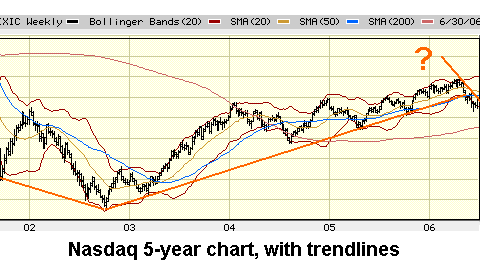

|
| weblog/wEssays archives | home | |
|
Sucker's Rally (July 1, 2006) Several readers have commented on my May 6, 2006 prediction that the stock market would decline precipitously starting May 11--which it promptly did (see Is the Stock Market on the Same Planet as the Economy? Obviously Not, May 6) Astute reader Harun Ibrahim recently shared what is clearly a knowledgeable trader's view of the stock market's recent rally. Your call about the market decline was interesting. I saw it coming from the perspective that Commercial traders were establishing large net short positions in Dow futures for some time. Ahead of the Fed Commercial traders increase positions net short from 21% to 54% (largest percent net short position in 10 years), Large traders increased 7% to 17% net long, and Small traders (generally the public) increased 14% to 37% net long (largest percent net long position in 10 years).In other words, while the smart money exited, the retail "investors" piled in-- just what I had surmised back in May. It's instructive to look at a chart of the Nasdaq market over the past 5 years. Note that the uptrend line from October 2002 has been decisively broken. 
Mr. Ibrahim was kind enough to send me two detailed spreadsheets of COT data and charts to support his comments. So please take note: the market is not "transparent, rational and a level playing field" as per the rah-rah Wall Street hype; that's just part of the con. If you want to "invest" (i.e. gamble) in the stock market, it's best to heed those with the analytic skills, skepticism and experience which Mr. Ibrahim clearly possesses. For what it's worth, an excerpt from my May 6 entry: Here's the real reason for the stock market's fairyland climb: Bubble follows bubble follows bubble. As the Dot-com stock bubble expired, dropping the NASDAQ from 5,300 to 1,100, the psychology of the Free Lunch--money for nothing but playing with money--transferred seamlessly to the real estate market, driving it to unprecedented classic-bubble heights. As this "free lunch money" (all $2.5 trillion of it) gushed into homeowner's pockets, about 2/3 was spent (according to Fed estimates cited in previous entries) but some flowed into other investments such as the resurgent stock market.Mr. Ibrahim also sent along a fascinating and deeply disturbing essay entitled The Real Reasons for the War in Iraq by William Clarke. The thesis is this: the U.S. must keep the dollar as the world's only commercial and reserve currency, and the war essentially serves that goal. More on this and the dollar in future entries. For more on this subject and a wide array of other topics, please visit my weblog. copyright © 2006 Charles Hugh Smith. All rights reserved in all media. I would be honored if you linked this wEssay to your site, or printed a copy for your own use. |
||
| weblog/wEssays | home |